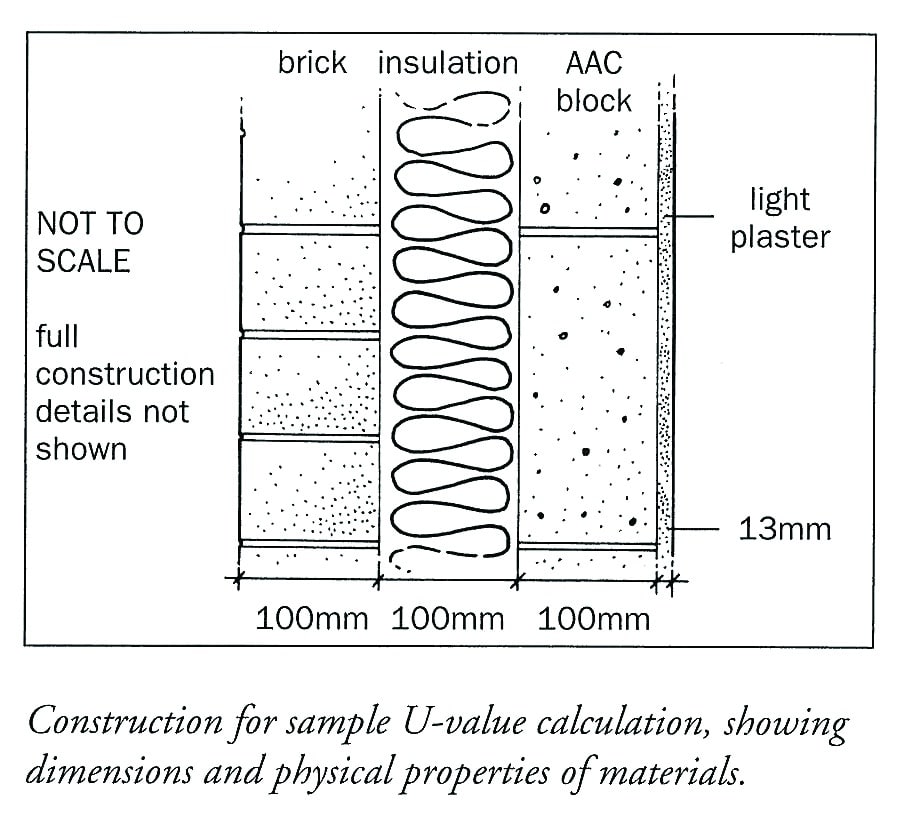In this article we cover:
- What are U-values?
- Why are U-values important?
- How to calculate a U-value
U-value: sound familiar? Do you know what it means and why you should? Something to do with energy? That’s getting warmer, and so will you if make sure you are fully aware and understand their importance when you design and build your new house, extension or renovation.
Definition
U- values are all about the rate at which heat passes through a material; this is known as “thermal transmittance”. In building it is used to indicate how well each section of the fabric – floor, roof or wall – will help the house to retain heat. The quicker heat passes through the material, the poorer it is at insulating and so it is given a high number. Materials with low U-values therefore are good at helping your house to retain its heat.
U-values are expressed in W/m2K – Watts per square metre Kelvin – that is, the heat energy transmitted per square metre of element and temperature difference either side of the element (Kelvin is equivalent to °C in terms of temperature difference). As Sir Isaac Newton told us, heat flows from a hotter body to a cooler one and it’s just the same in our houses as we try to keep the inside temperature comfortable when it’s cold outside, or vice versa on a hot summer’s day.
If we know the area and U-value of a material, as well as the temperature inside and out, we can calculate the “steady state” heat loss (Watts) from the house. Back in the days when oil was plentiful and we were not as conscious of waste, this is how heating installers worked out how many radiators and what size of boiler you needed. Because it was based on making sure you were able to put enough heat into the house to keep it warm on the coldest day of the year, this approach tended to oversize boilers and radiators.
Nowadays we use U-values to indicate the overall energy efficiency of the building fabric and to allow comparisons to be made between different methods of construction and building materials. They are also used to express the legal minimum energy performance requirements in the Building Regulations.
Although I work every day with them, it was only when I came to write this article that I realised I didn’t know where the name came from! The earliest reference to U-values that I could find was 1949 and the answer seems to be simply an abbreviation for “Unit-value”, that is, the heat energy passing through a “unit” of material under a given temperature difference.
Why are U-values important
First and foremost because of Building Regulations: Part F in NI and Part L in ROI. Theses require that elements of new buildings (and extensions and change of use) do not exceed certain maximum permissible U-values, representing minimum energy efficiency performance.
Prior to the latest revision of the Building Regulations in NI, compliance with Part F could be demonstrated in one of two ways – the Elemental Method and the Calculated Trade-off Method. Part L in ROI took a similar approach, with the Elemental Method and the Overall Heat Loss Method. With the elemental approach, you had to ensure that the
U-values for each building element did not exceed a maximum permitted value. Parts of an individual element (eg part of the walls) were allowed to reach a certain higher maximum value, provided the area-weighted average U-value for all parts of that element did not exceed the maximum overall value. This is still represented in the current Building Regulations via the “long-stop U-values” – values which you are not allowed to exceed. However, compliance depends on other factors too (such as air-tightness, heating system efficiency and use of low carbon technologies), which all contribute to the carbon dioxide (CO2) emissions rate. To comply with the Regulations in NI, the Dwelling Emissions Rate (DER) must not exceed the Target Emissions Rate (TER).
The reason for the long-stop U-values is in case, for example, a low carbon heating system was used which, typically, would easily allow the dwelling to comply on DER/TER. By giving upper limits for the fabric as well, that ensures all the benefit from the heating system isn’t then lost through a poorly insulated fabric. In addition, you only put insulation in once (except, perhaps, in your roof space) so not only should it be done correctly, to future-proof the house you should use as much as budget and design allow
It’s exactly the same in ROI (we’re all part of the EU now), with maximum overall and area-weighted U-values for each element. In addition, you must not exceed the maximum permissible energy performance coefficient (MPEPC), in primary energy terms, and the maximum permissible carbon dioxide coefficient (MPCPC). Both of these requirements are based on a Reference Building to assumed standards.
The ‘bottom line’ could be important as well. With a low energy house the running costs are reduced which should make your plans more attractive to lenders. You can also argue that your house will hold its value far better than others as energy is now a factor in the sales process.
How to calculate a U-value
The easiest way is to use a U-value calculator on your pc, or through using SAP (Standard Assessment Procedure) or DEAP (Dwelling Assessment Procedure).
In the absence of these, and if you’d like to give your brain some exercise, you can still do it manually which does help to give a better understanding of the meaning of U-values and what they represent.
Note Americans tend to use and refer to R, for thermal resistance, which is the reciprocal of our U-value. This has the advantage of giving a bigger number for more insulation which is often easier to relate to.
For us, lower is better. In NI, a U-value of 0.35W/m²K for external walls is the maximum permissible average area-weighted value; in ROI it is 0.27 W/m2K.
When working out a U-value, you begin with the R value. The R value is the sum of the individual resistances (r) of all the material layers in the element. The individual resistances are calculated from the thickness (l) of the material divided by its thermal conductance (k-value), a physical property which varies from one material to another, but is constant for a given material. The full calculation procedure is thus;
r=l/k
R = (r1 + r2 + r3 + …etc)
U = (1/R).
A sample U-value calculation is shown below.



















